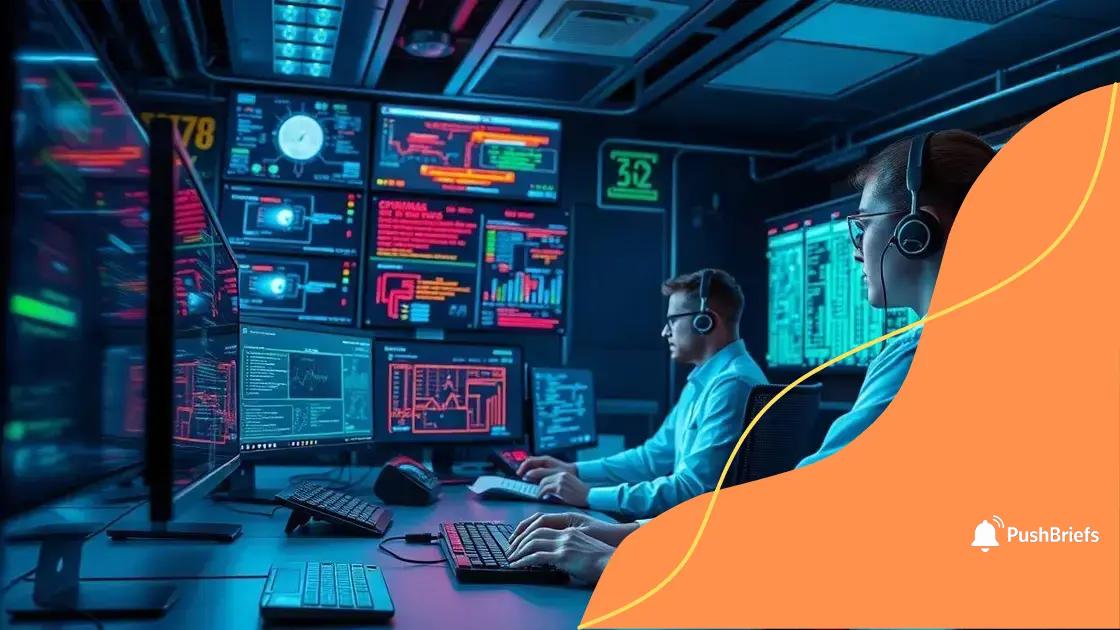Efforts to address cybersecurity threats are ongoing and urgent

Future trends in cybersecurity defense include adopting Zero Trust Architecture, utilizing AI for threat detection, enhancing employee training, and prioritizing data privacy to combat evolving cyber threats effectively.
Efforts to address cybersecurity threats are ongoing, and it’s critical to stay informed. With new challenges around every corner, how prepared are we really? Let’s explore this pressing topic.
Understanding cybersecurity threats today
Understanding cybersecurity threats today is essential for keeping our information safe. With technology evolving rapidly, new challenges arise constantly, making it crucial to stay informed about these threats.
Types of Cybersecurity Threats
There are many different types of cybersecurity threats that organizations face. The awareness of these can help in developing effective prevention methods.
- Malware: Malicious software designed to harm or exploit devices.
- Phishing: Deceptive emails aimed at stealing personal information.
- Ransomware: A type of malware that locks data until a ransom is paid.
- Insider threats: Risks posed by employees or contractors with access to sensitive information.
As we explore these threats, it becomes clear that each type requires unique defenses. Staying aware of recent trends is key. For instance, the rise of remote work has increased exposure to potential breaches. Cybercriminals often target home networks, which may not be as secure as corporate networks.
Impact on Businesses
The impact of cybersecurity threats can be devastating. Organizations can face significant financial losses due to breaches, alongside damage to their reputation. Companies that do not proactively address these threats often find themselves in difficult positions after an attack.
Moreover, the consequences extend beyond immediate financial losses. Companies may lose valuable customer trust and face legal ramifications. Investing in cybersecurity measures is not just a precaution; it is a necessity for survival in today’s digital age.
Staying Informed
To combat cybersecurity threats, it is vital to stay informed about the latest developments. Regular training for employees on how to recognize threats is also essential. By fostering a culture of cybersecurity awareness, organizations can greatly reduce their risk.
Incorporating advanced cybersecurity tools can also help mitigate threats effectively. Tools like firewalls, antivirus software, and intrusion detection systems play a significant role in protecting data. As new threats emerge, having a proactive approach is necessary.
Key strategies for enhancing cybersecurity
Key strategies for enhancing cybersecurity are essential to protect sensitive information. By utilizing various methods, organizations can create robust defenses against potential threats.
Regular Updates and Patching
Keeping software and systems up to date is a fundamental step. Regular updates ensure that known vulnerabilities are addressed, making it more difficult for cybercriminals to exploit weaknesses.
- Automate updates: Use automated tools to install patches and updates regularly.
- Monitor software: Keep track of all software used within the organization.
- Conduct vulnerability assessments: Regular assessments will identify areas needing improvement.
In addition to updates, employees play a crucial role in cybersecurity. They need to be aware of best practices and the latest security trends. Training is essential for keeping staff informed and vigilant about potential attacks.
Implementing Strong Access Controls
Access control measures limit data exposure to only those who need it. This practice can significantly reduce the risk of unauthorized access.
Consider integrating multi-factor authentication (MFA) for additional security, as it adds a layer of protection beyond just passwords. Enforcing strong password policies is another essential strategy. Encouraging users to create complex passwords helps prevent easy breaches.
Regular Security Audits
Performing regular security audits allows organizations to evaluate their defenses continually. Auditors can pinpoint weaknesses and provide suggestions for improvement. These audits can cover:
- Network security: Assess the security of the network infrastructure.
- Data security: Examine how sensitive information is protected.
- Compliance measures: Ensure adherence to regulations.
In conclusion, enhancing cybersecurity is an ongoing process that requires a multifaceted approach. By implementing these key strategies, organizations can build a stronger defense against the evolving landscape of cyber threats.
Emerging tools to combat cybersecurity issues

Emerging tools to combat cybersecurity issues are evolving rapidly, addressing new threats effectively. These innovations help organizations defend themselves against increasing cyber risks.
AI and Machine Learning
Artificial Intelligence (AI) and machine learning play a significant role in modern cybersecurity. They analyze vast amounts of data quickly, identifying potential threats before they can cause harm. These technologies can learn from patterns, improving their detection capabilities.
- Predictive analytics: This approach helps in forecasting potential attacks by assessing trends.
- Behavioral analysis: AI can monitor user behavior, flagging any unusual activity.
- Automation: Automated responses can help contain threats almost instantly.
In addition, many organizations are turning to advanced threat intelligence platforms that provide real-time data about emerging threats. By integrating such tools, businesses can enhance their situational awareness and responsiveness.
Cloud Security Solutions
As more companies migrate to cloud environments, new cloud security solutions become essential. These tools protect data stored in the cloud from unauthorized access and attacks, ensuring robust security controls.
Cloud access security brokers (CASBs) enforce security policies, providing an additional layer of protection. These solutions help manage user identities and maintain compliance, safeguarding sensitive data from potential breaches.
Endpoint Detection and Response (EDR)
EDR solutions are crucial for monitoring endpoints such as computers and mobile devices. They identify potential threats at these entry points and respond to incidents swiftly to avoid larger breaches.
- Continuous monitoring: EDR tools constantly assess threats to endpoints.
- Incident response: They can automate responses to suspicious activities, minimizing damage.
- Data collection: Detailed logs from endpoints help analyze and identify attack patterns.
A combination of these emerging tools allows organizations to develop a strong cybersecurity posture. By incorporating innovative technologies, businesses can remain resilient against ever-evolving cyber threats.
The role of training in cybersecurity
The role of training in cybersecurity cannot be overstated. Effective training programs empower employees to recognize and respond to potential threats. Given the increasing complexity of cyber attacks, ongoing education is essential.
Importance of Awareness
Employee awareness is a critical line of defense against cybersecurity threats. When staff members understand common attack methods, such as phishing or social engineering, they can help prevent breaches.
- Phishing simulations: Conducting realistic simulations helps employees identify phishing attempts.
- Regular workshops: These sessions keep staff updated on the latest cybersecurity practices.
- Clear communication: Encourage reporting any suspicious activities through a designated channel.
Creating a culture of security begins with effective training. Employees should feel confident in their ability to handle security issues and feel responsible for protecting company data.
Hands-on Training
Hands-on training can solidify knowledge and skills. By engaging employees in practical exercises, they learn how to deal with real-world threats.
For instance, role-playing attacks can help staff practice their response strategies. Additionally, platforms that provide interactive modules enhance engagement and retention of information. This way, employees are better prepared for potential cyber incidents.
Continuous Learning
Cybersecurity is always changing, making continuous learning vital. Regular updates to training materials ensure relevance as new threats emerge.
- Certifications: Encourage employees to pursue cybersecurity certifications to deepen their knowledge.
- Online resources: Provide access to updated online courses and webinars.
- Feedback loops: Incorporate feedback to improve training programs over time.
Equipping employees with the right skills and knowledge can significantly reduce the risk of cyber incidents. Training is not a one-time event but an ongoing commitment to cybersecurity.
Future trends in cybersecurity defense
Future trends in cybersecurity defense are rapidly evolving to keep pace with advancing technology and increasing threats. Organizations must stay informed about the newest strategies and tools available to protect their data.
Zero Trust Architecture
One of the most significant trends gaining traction is the adoption of Zero Trust Architecture. This approach assumes that every user and device is a potential threat, so verification is required at every access point.
- Continuous authentication: Users must be authenticated continuously, not just once at login.
- Least privilege access: Access is granted only to the resources necessary for a user’s role.
- Micro-segmentation: Dividing networks into smaller segments makes it harder for attackers to move laterally.
This model enhances security by eliminating unnecessary trust, making it a crucial component in the future of cybersecurity.
Artificial Intelligence and Machine Learning
The use of artificial intelligence (AI) and machine learning is set to become more prevalent in cybersecurity. These technologies can analyze vast amounts of data and identify patterns that indicate potential threats.
AI-driven tools can also automate responses to attacks, allowing for quicker action and reduced damage. Additionally, machine learning algorithms can adapt to new threats more effectively than traditional methods.
Increased Focus on Data Privacy
As regulations surrounding data privacy become stricter, organizations will need to prioritize compliance. Future cybersecurity strategies will need to integrate data privacy measures to ensure protection against breaches.
- Privacy by design: Incorporating privacy measures from the beginning of development processes.
- Regular audits: Conducting audits to assess compliance with data protection regulations.
- Employee training: Educating staff about data privacy practices and regulations.
Organizations that prioritize data privacy will not only comply with regulations but also build trust with their customers.
Remote Work Security Solutions
With remote work becoming more common, future cybersecurity defenses will focus on securing remote access. Solutions will need to accommodate employees working outside the traditional office setting.
This will include stronger endpoint security measures, ensuring that all devices connecting to corporate networks are secure. It will also involve enhancing virtual private networks (VPNs) and secure access service edge (SASE) technologies.
In conclusion, staying ahead in cybersecurity requires understanding current trends and investing in effective strategies. Embracing technologies like artificial intelligence, adopting a Zero Trust approach, and enhancing employee training are vital to protect sensitive information. As cyber threats continue to evolve, organizations that prioritize security measures and data privacy will better safeguard their assets and build trust with their clients. Preparing for future challenges is essential for a secure digital landscape.
FAQ – Frequently Asked Questions about Cybersecurity Trends
What is Zero Trust Architecture?
Zero Trust Architecture is a security model that requires verification for every user and device trying to access resources, assuming that threats can be internal or external.
How does AI enhance cybersecurity?
AI enhances cybersecurity by analyzing large volumes of data to detect patterns and automate responses to security threats quickly.
Why is employee training important in cybersecurity?
Employee training is crucial because it helps staff recognize and respond to potential threats, significantly reducing the risk of breaches.
What are the trends in data privacy?
Trends in data privacy include stricter regulations and an emphasis on ‘privacy by design,’ ensuring that data protection measures are integrated from the outset.
